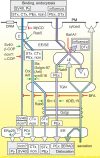Retrograde transport pathways utilised by viruses and protein toxins
- PMID: 16603059
- PMCID: PMC1524934
- DOI: 10.1186/1743-422X-3-26
Retrograde transport pathways utilised by viruses and protein toxins
Abstract
A model has been presented for retrograde transport of certain toxins and viruses from the cell surface to the ER that suggests an obligatory interaction with a glycolipid receptor at the cell surface. Here we review studies on the ER trafficking cholera toxin, Shiga and Shiga-like toxins, Pseudomonas exotoxin A and ricin, and compare the retrograde routes followed by these protein toxins to those of the ER trafficking SV40 and polyoma viruses. We conclude that there is in fact no obligatory requirement for a glycolipid receptor, nor even with a protein receptor in a lipid-rich environment. Emerging data suggests instead that there is no common pathway utilised for retrograde transport by all of these pathogens, the choice of route being determined by the particular receptor utilised.
Figures

References
-
- Fujinaga Y, Wolf AA, Rodighiero C, Wheeler H, Tsai B, Allen L, Jobling MG, Rapoport T, Holmes RK, Lencer WI. Gangliosides that associate with lipid rafts mediate transport of cholera and related toxins from the plasma membrane to endoplasmic reticulm. Mol Biol Cell. 2003;14:4783–4793. doi: 10.1091/mbc.E03-06-0354. - DOI - PMC - PubMed
-
- Sekura R, Moss J, Vaughan M. Pertussis toxin. Orlando , Academic Press; 1985.
-
- Buckley JT, Halasa LN, Lund KD, MacIntyre S. Purification and some properties of the hemolytic toxin aerolysin. Can J Biochem. 1981;59:430–436. - PubMed
Publication types
MeSH terms
Substances
Grants and funding
LinkOut - more resources
Full Text Sources
Other Literature Sources

